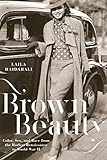Brown Beauty : Color, Sex, and Race from the Harlem Renaissance to World War II / Laila Haidarali.
Material type: TextPublisher: New York, NY : New York University Press, [2018]Copyright date: ©2018Description: 1 online resource : 5 Illustrations, color, 22 black and white illustrationsContent type:
TextPublisher: New York, NY : New York University Press, [2018]Copyright date: ©2018Description: 1 online resource : 5 Illustrations, color, 22 black and white illustrationsContent type: - 9781479875108
- 9781479865499
- African American women -- Race identity -- 20th century
- African American women -- Social conditions -- 20th century
- Beauty, Personal -- Social aspects -- United States -- 20th century
- HISTORY / United States / 20th Century
- African American literature
- African American womanhood
- African American women
- African American youth
- Brown v Board of Education
- Charles H Parrish
- Charles S Johnson
- Cold War politics
- Dark Princess A Romance
- Elise Johnson McDougald
- Franklin E Frazier
- Great Depression
- Harlem Renaissance fiction
- Harlem educator
- New Negro woman
- New Negro
- The Crisis
- W E B Du Bois
- WWII
- black beauty ideals
- black middle class
- brown skin beauty ideals
- brown skin models
- brown-skin mulatta
- consumer advertising
- consumption
- cosmetics
- gender politics
- interwar years
- literary journals
- middle class
- mixed race
- new woman
- print culture
- race concept
- racial liberals
- transnational activism
- urbanization and race
- woman's era
- women's poetry
- 305.48896073 23
- E185.86 .H225 2019
- online - DeGruyter
| Item type | Current library | Call number | URL | Status | Notes | Barcode | |
|---|---|---|---|---|---|---|---|
 eBook
eBook
|
Biblioteca "Angelicum" Pont. Univ. S.Tommaso d'Aquino Nuvola online | online - DeGruyter (Browse shelf(Opens below)) | Online access | Not for loan (Accesso limitato) | Accesso per gli utenti autorizzati / Access for authorized users | (dgr)9781479865499 |
restricted access online access with authorization star
http://purl.org/coar/access_right/c_16ec
Examines how the media influenced ideas of race and beauty among African American women from the Harlem Renaissance to World War II. Between the Harlem Renaissance and the end of World War II, a complicated discourse emerged surrounding considerations of appearance of African American women and expressions of race, class, and status. Brown Beauty considers how the media created a beauty ideal for these women, emphasizing different representations and expressions of brown skin.Haidarali contends that the idea of brown as a "respectable shade" was carefully constructed through print and visual media in the interwar era. Throughout this period, brownness of skin came to be idealized as the real, representational, and respectable complexion of African American middle class women. Shades of brown became channels that facilitated discussions of race, class, and gender in a way that would develop lasting cultural effects for an ever-modernizing world. Building on an impressive range of visual and media sources-from newspapers, journals, magazines, and newsletters to commercial advertising-Haidarali locates a complex, and sometimes contradictory, set of cultural values at the core of representations of women, envisioned as "brown-skin." She explores how brownness affected socially-mobile New Negro women in the urban environment during the interwar years, showing how the majority of messages on brownness were directed at an aspirant middle-class. By tracing brown's changing meanings across this period, and showing how a visual language of brown grew into a dynamic racial shorthand used to denote modern African American womanhood, Brown Beauty demonstrates the myriad values and judgments, compromises and contradictions involved in the social evaluation of women. This book is an eye-opening account of the intense dynamics between racial identity and the influence mass media has on what, and who we consider beautiful.
Mode of access: Internet via World Wide Web.
In English.
Description based on online resource; title from PDF title page (publisher's Web site, viewed 01. Nov 2023)


